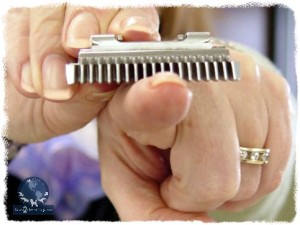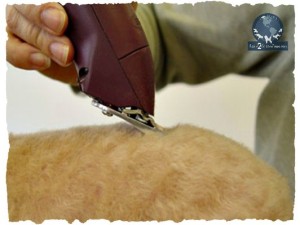Do you struggle to get the spindly legs smooth of that clipped #5 all trim? The body comes out nice and smooth – but the legs… ugh.
Getting smooth legs is always a pesky problem for new groomers. Maybe you’ve been grooming for a while, but still struggle with this area. You’re not alone. Legs should only take you a few minutes to get smooth. If you’re missing the mark, here’s some help.
My Golden Rule for All Clipper Work
3 passes and you’re done. Period.
Your end result should be super smooth. No rough spots. No sticky-outies.
Fast. Clean. Simple.
 Legs have their own sets of challenges. One of the largest issues is simply the shape. When you set a clipper blade on one of those spindly legs, the point of contact is minimal. Look at it on your own finger, simulating a leg. You’re only making contact with one or two teeth. You’re going to have to rapidly go over those legs several times if you have any hope of getting them smooth.
Legs have their own sets of challenges. One of the largest issues is simply the shape. When you set a clipper blade on one of those spindly legs, the point of contact is minimal. Look at it on your own finger, simulating a leg. You’re only making contact with one or two teeth. You’re going to have to rapidly go over those legs several times if you have any hope of getting them smooth.
I have some ideas for how to get a nice finish on those legs in no time. It’s easy when you understand the principles and the foundation skills of all good clipper work.
1. Don’t skimp on the prep.
An excellent bath and a quick high velocity blow dry can make a world of difference in your finish – even on #10 or #7 all over trim. If they have six weeks or less of coat, get them into the tub right away. It won’t take you any more time to bathe and blow them dry and you will get a superior finish.
If the dog has more than six weeks growth, quickly knock off the bulk of the coat. Don’t worry about getting it smooth or neat at this point. Just remove the bulk of the coat as fast as you can. You don’t need to be bathing and drying all of that extra hair. Once the bulk of the fur is removed, head to the bathtub. Follow up with a quick high velocity dry to get the coat to stand up and away from the dog’s body.
If the dog will not tolerate a high velocity dryer, don’t worry. Just make sure they are thoroughly towel-dried. Give the pooch a light mist with a coat amplifying product or hairspray. Use a soft slicker brush to back brush and work the product into the coat while it is still damp. Let them air dry in a comfortable environment until they are dry and ready for finish trimming. Keep in mind this is a very short haircut and fluff drying is not really necessary.
2. Know your holds.
There is an order that you need to work over the legs to be efficient. Start from the top and work down to the toes.

Whenever you are working on legs, always keep them as low to the table as possible. The higher you lift the leg, the more uncomfortable the pet is going to become. As they become uncomfortable – they struggle. They nip. They whine. They squeal.
You need to be absolutely clear on whether you’re honestly hurting the pet or if they’re just being difficult. If you do not lift the leg more than an inch or two off the table, more than likely, they are just being difficult. Proceed in a calm, cool, and collected manner.
To get the top of the legs, hold onto the toes. I place my finger into the crevices of the foot pad. Then I press down between the digits so only skin is trapped between my fingers. Then I have a good hold so that I can maneuver the leg low to the table but I can get clearance all the way around.
If you’re holding them correctly, and they still struggle, simply maintain your hold. Anchor the heel of your hand on the table while you’re still holding onto the toes. Let the pet lightly resist your hold. After a few tries, and you don’t let go, most dogs stop pulling. You have gently and quietly taught them to hold still for the clipping procedure. Yeah! Minor victory for you! Be sure to give them praise when they do well and begin to respond positively.
For the toes, it’s a little trickier. For the front legs grasp the top of the leg above the elbow joint, then gently squeeze with your thumb and first finger. This hold will also offer stability as your hands rest in the armpit area. As you squeeze you will notice the dog will literally point its paw. This will give you enough rigidity in the pastern joint to run the clipper smoothly over the foot area, getting a smooth cut.
On the back legs, you’re going to slide your hand underneath the dog’s thigh. Stretch your fingers so that they can sit just above the ischium joint (point of buttocks) and the stifle joint. With the leg slightly off the table top, squeeze gently. Just like on the front, the joint will become stiff and the dog will point its toe. This will give you the firmness you need to work the clipper over the foot area.
3. Tip of the clipper.
No matter what blade you use, it is important to maintain a consistent degree of tip to the clipper blade. This is also known as “keeping the blade up on it’s cutting edge.” Imagine a pencil being held right under the blade as you guide it down the leg. The closer the pencil is to the teeth, the higher the tip angle. The further back you keep the imaginary pencil, lesser of the degree of tip. Generally speaking, the closer the blade cuts, the higher you need to tip the blade for it to be effective.
 Equally important is the amount of pressure placed on the blade. The perfect pressure is the weight of the clipper. Let gravity do the work. When you get in those awkward positions, you will need to simulate the same amount of pressure as your work on the sides and under the dog. Use your own arm to teach you how to gauge the pressure while maintaining consistent pressure as you would maneuver around the dog.
Equally important is the amount of pressure placed on the blade. The perfect pressure is the weight of the clipper. Let gravity do the work. When you get in those awkward positions, you will need to simulate the same amount of pressure as your work on the sides and under the dog. Use your own arm to teach you how to gauge the pressure while maintaining consistent pressure as you would maneuver around the dog.
4. Don’t forget to brush.
It’s important to back brush. On the shorter trims, a softer brush is generally your best choice. Back brushing is done with the slicker brush while brushing the coat against the grain. The pressure on the brush should be very light. Use the entire pad of the brush, making gentle contact with the skin and coat. Keep the pressure soft on the brush so the skin is not scraped, causing a potential “brush burn.” Back brush the entire leg once. Then make multiple clipper passes using effective techniques. Once the bulk of the coat is gone, repeat the process a second time to get a smoother finish. On the third back brush pass, there should only be high spots or uneven areas left to get with the clippers.
5. The final detail finish.
Once you have back brushed and clipped the legs three times there should be very little coat left, but there are always a few pesky strays that pop out.
This is the time to pull out a nice pair a blending shears. For this type of detail work, I prefer a finer toothed blender or thinning shear. I always opt for blenders over normal shears for safety reasons. I rarely opt for a smooth bladed shear. The risk of injury is just too great. A blending or a thinning shear is a much safer option to get those final stray hairs you just couldn’t pick up with the clipper.
As a professional pet groomer or stylist, you always want the dog to look its best. Uneven haircuts do not reflect positively on a professional salon. You must be able to do a significantly better job than the dog’s owners could do themselves.
Dealing with all four legs on small to medium-sized pets should not take more than 1 to 3 minutes per leg to complete the bulk of the clipper work. Never forget, as much as we love our jobs, time is money. You want to become as efficient as possible.
Pay attention to the details. There’s a difference between a good #7 All and a bad #7 All. If you want your clients to return – you need to pay attention to the details. These low maintenance style trims are the bread-and-butter of many professional grooming salons. Getting those low maintenance haircuts super-smooth in the least amount of time possible is the key to a successful salon
Melissa

What is your secret to getting legs smooth? What frustrates you? Jump on our Facebook page and share with your Melissa Verplank family.

